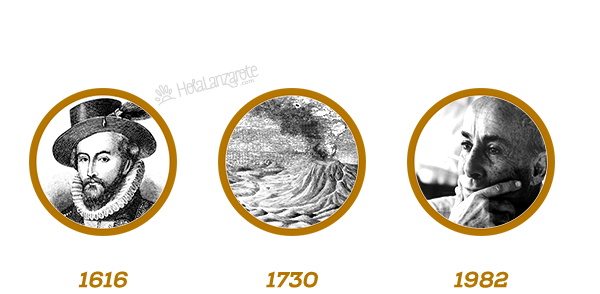
The history of Lanzarote is a combination of cultures and breeds in constant struggle to overcome the obstacles of the island's distance and water shortage.
Lanzarote, known in ancient times by Phoenicians and Romans, was inhabited by people of Berber descent for at least two thousand years. This population, known as majos, lived from grazing, fishing and very limited agriculture.
At the end of the Middle Ages there were visits of Genoese or Castilian navigators, until the Norman Jean de Bethencourt, under the orders of the Spanish crown, began in the south of Lanzarote the process of conquest of the whole Archipelago.
Located in a strategic geographical position, and incorporated into the vast Spanish empire of the time, the Canary Islands not only became key points for the incessant commercial and cultural traffic with the new lands of America but they increased their relation with European countries like Portugal, England or France.
Lanzarote, meanwhile, consolidated as a feudal lordship and began a stage of growth very timid, marked by turbulence caused by economic fragility and frequent piratical attacks.
The modern history of Lanzarote underwent a significant change in 1730, when a period of powerful volcanic eruptions began, transforming the island and which at first provoked a rush of terror, soon became a source of prosperity.
The inhabitants of the island, exacerbated by centuries of struggle for survival, they created an unique model of agriculture in the world with volcanic ash predominating in the island landscape. These crops allowed for greater production and so, they were able to increase exports. However, the development of the island in recent centuries has been marked by a combination of positive economic cycles (thanks to crops such as orchilla or cochineal) and critical phases of acute drought, famine and emigration.


I millennium BC, first human arrivals to Lanzarote.
1312, first accurate visit of a European: Lancelotto Malocello, probably Lanzarote, owes his name to this Genoese expeditionary. He stayed for about two decades.
1402, arrival of Jean de Bethencourt, baron of La Grainville, and Gadifer de La Salle, knight skilled in battles. These nobles are received by the king of Lanzarote, Guadarfía, and they agree a pact of friendship and not aggression.
1407, Maciot de Bethencourt, first governor of Lanzarote by delegation of his uncle, the baron. He marries Princess Teguise of Lanzarote. They are the main tree of which the different branches of Bethencourt, Betancort and Betancor in Lanzarote, the Canary Islands and America.
1584, Agustin de Herrera y Rojas, is named by King Philip II, I Marquis of Lanzarote. Prototype of noble of the time, who stood out for from a very young age by his courage and boldness.
1616, Sir Walter Raleigh attacks Lanzarote. One of many piratical attacks that devastated the island and the archipelago during the XVI, XVII and XVIII centuries.
1730-1736, first historical volcanic eruptions. These leave the present morphology of the island, turning Lanzarote into mythical place.
1852, Arrecife, capital of Lanzarote. Under Francos' Free Port Law, from August 10, Teguise ceases to be the economic and political center of the island.
1982, César Manrique, creates the Foundation that bears his name. Queen Sofía, President of Honor. The Cesar Manrique Foundation, has become a cultural reference throughout the archipelago.
The traditional precariousness of Lanzarote initiated a radical metamorphosis in the second half of the twentieth century. This economic takeoff coincided with the profound political and social changes that have lived the Canary and Spanish society in the last thirty years.
First it was thanks to the push of a fishing industry linked to the marine wealth of the Sahara coast, but just as this source of income declined, the island began a spectacular tourism development that was lucky enough to come up with an original model with the help of César Manrique.
This artist led a series of aesthetic performances in unique natural areas, combining the power of architecture with respect for the environment. With this, Lanzarote - now a first-class tourism destination - not only offers a privileged climate all year round, but has also enhanced its cultural and environmental heritage. An island carried out by its unusual landscape, that is to say, by what nature and man have left engraving in the skin of the territory during the previous centuries.
To know the History of Lanzarote it is necessary to know the history of its people, their customs, and their art. In spite of the fact that much information of its first inhabitants is of limited form, due to the lack of archaeological finds. The volcanic eruptions that have left such an impressive landscape, also destroyed and buried many houses and with them the trace of how they lived then, utensils, paintings, etc. Lanzarote also had continuous looting of conquerors and pirates, who destroyed or took what they found in their path.
Part of the Lanzarote history, it looks directly at how the Lanzarote population has known to take advantage of its arid lands and the cultivation of life is also part of its history.
You can find out more about history of Lanzarote at the Castillo de San Gabriel and its the historic museum.